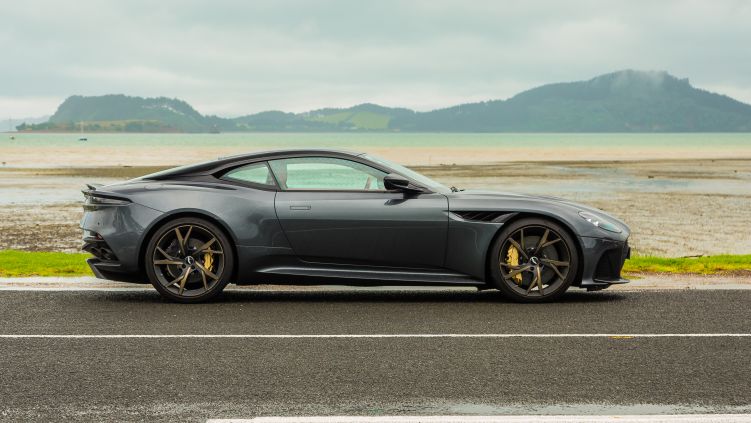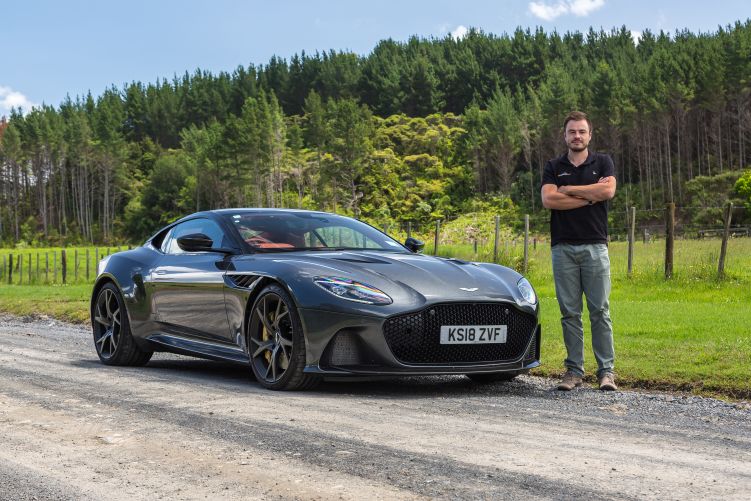Just my luck. We received an invitation to drive the all-new 2019 Aston Martin DBS Superleggera in New Zealand, through some of the most scenic coastline you’ll ever lay eyes on.
But, despite being right in the midst of summer, the weather forecast showed rain, more rain and even more rain. With our flights and the car already booked in, we cracked on and decided to make the most of it.
The DBS name is steeped in history at Aston Martin – it’s the brand’s designation for a grand tourer and first appeared in 1967, and was even used by James Bond in On Her Majesty’s Service in 1969. After a 35-year break, the name was back again in 2007 through to 2012. Fast-forward to 2018 and Aston Martin has unleashed the DBS name once more, this time in Superleggera form, which is Italian for ‘super light’, for the uninitiated.
Let’s take a second to appreciate how unbelievably stunning the DBS Superleggera looks. Based on the DB11, it takes styling to another level with a unique rear and front-end treatment, along with a 72kg weight reduction in comparison to its DB11 V12 AMR sibling.
Our test car was finished in a stunning Xenon grey exterior colour with 21-inch forged duotone gloss and satin black wheels with yellow brake callipers.
If you just spend a second looking at some of the finer details of the car, it’s easy to get lost in the curves and aero-centric design elements spread around the exterior.
Air can take a number of paths at the front of the car. It can either be pushed across the radiator and through the engine bay, exhausting through the hood vents. Or, it can follow a path through the front, across the tyre and brakes, exhausting the front straifs, across the side of the body and then through the rear three-quarter inlets, where it travels through a set of vanes to create downforce on the spoiler.
At top speed (340km/h), the DBS Superleggera is generating 180kg of downforce at the rear. Just think about that for a second. At 340km/h … That’s 152 metres per second … Almost 200kg of extra weight is being exerted on the rear to keep the car planted.
This extra downforce acts to offer extra traction across the 305mm-wide tyres at the rear. While you generally won’t feel this downforce in action, you would certainly notice it if it were to be taken away immediately.
The chunky rear tyres work in unison with 265mm-wide tyres at the front and whopping 410mm-wide rotors at the front, coupled with 360mm rotors at the rear – both carbon ceramic.
Read more: DBS news, reviews, comparisons and videos
Before we get stuck into what the DBS Superleggera is like to drive, it’s worth considering the cost – and certainly the added cost of owning this car in Australia.
Pricing kicks off at $517,000 plus on-road costs in Australia, which makes it the most expensive Aston Martin on sale in Australia at the moment. On top of that asking price, there’s around $30,000 in stamp duty to be paid, which puts the realistic drive-away price at around $560,000.
Due to around $100,000 in luxury car tax, the same car when sold in New Zealand costs around $443,000. Yep, we get seriously ripped off in Australia. Anyway, it doesn’t detract from the car, but it’s part of the reason why the luxury car tax makes no sense, given we have no local car industry to protect any longer.
As you’d expect, there’s a litany of options you can add to the DBS Superleggera. While most of them are a box-ticking exercise to bring the car up to a civil specification, the amount of customisation on offer in terms of colour and trim is next level.
Just have a look at the interior of our test car. When I cracked the door for the first time, I wasn’t sure if I needed to take my shoes off and press my clothes before going anywhere near it. It’s just a work of art, and is part of the reason you would gladly blow the best part of half a million dollars on a car.
Triaxial quilting on the seats of our test car was teamed with a red leather treatment throughout the cabin that was impossible to fault. Even small details like the detailed stitching on the centre console lid was done to perfection, ensuring durability and timeless style.
One of the biggest benefits of Aston Martin’s involvement with Mercedes-Benz is the interior technology. While the COMAND system isn’t great, nor is it the best in the business, it’s a huge leap forward from the Volvo-era infotainment systems used in Aston Martins of yesteryear.
Even the driver cluster is now high-tech with accessible trip and performance information, in addition to easy switching through drive and ride modes using the steering wheel. It’s a well-thought-out system that functionally works really well.
Storage throughout the cabin is also good, with two seats in the rear and a retractable centre console lid that slides out of the way at the push of a button. Option the Bang and Olufsen sound system and you’ll also score omnidirectional tweeters that rise out of the dashboard each time you start the car.
But, technology and fancy features mean nothing if the car doesn’t deliver on the performance front.
Crammed under the bonnet of the DBS Superleggera is a 5.2-litre twin-turbocharged V12 engine that produces 533kW of power and a stonking 900Nm of torque – 900Nm … Get your head around that figure, because it’s huge.
Mated to a new ZF Sachs rear-mounted eight-speed automatic transmission, torque is limited in first and second gears to both preserve the gearbox and also ensure you get traction.
And traction is something you need, because with 900Nm of torque available virtually instantly, the 305mm-wide Pirelli rubber needs all the help it can get to deliver torque to the road. By limiting torque output in first and second gears, the DBS Superleggera can sprint from 0–100km/h in just 3.4 seconds and more impressively from 0–160km/h in 6.4 seconds.
Hit the starter button and the rumble sometimes lacking from the DB11 V12 is here for everybody to hear. It’s that deep, hollow supercar sound that Aston Martins are well known for, and it can be heard from miles away when you’re really getting up it.
The greatest appeal to this car is its ability to be driven as a daily driver. We talk a lot about daily drivers, and most supercars fail the daily driver test because they’re hard to see out of, impossible to park and not car park friendly.
This car meets that brief. Along with a 360-degree camera and both front and rear parking sensors, it’s easy to place on the road and has enough clearance at the front to enter and exit most driveways and navigate most underground car parks – plus there’s a semi-automatic parking feature.
Both doors open swinging slightly upwards, which means running doors into gutters when parked off-camber is a thing of the past. The steering is also light enough in Comfort mode to easily get the car in and out of parking spaces.
After a day of constant rain with traction at a premium, we thought our opportunity to have a proper drive and shoot our video would be lost. But, the next morning we woke up to blue skies and dry roads, so we fled as quickly as we could for some amazing driving roads around the eastern part of the north island.
I’ve driven a lot of fast cars, but the DBS Superleggera takes fast to an all-new level. It took me a while to wind up the courage to attempt a full-throttle blast through a winding stretch of mountain road with long straights.
I’m trying to find the best way to describe it, but it’s hard to imagine that this is in fact a rear-wheel-drive car. The way it piles on speed is unimaginable to the point where talking to the camera while driving is kind of sketchy!
The body sits dead flat through corners, and once the tyres are warm there’s a seemingly endless amount of grip on offer. Feed the throttle in out of a corner and it hooks up like you wouldn’t believe.
Be a little too generous with the throttle out of a corner, or even in a straight line, and it will kick and shimmy as it settles the rear end. You need to be lightning fast with throttle and steering inputs to make sure the car keeps moving in a straight line.
The DBS Superleggera and all-new Ferrari 812 Superfast enter an all-new era of supercar technology and pace. These engines offer refinement and incredible torque delivery that you would only expect to feel in a supercar or even a hypercar.
Wiping off speed is as important as piling it on, and this is where the carbon-ceramic brake package comes into its own. On the open road, these brakes are fade-free. No matter how hard you hammer them, they deliver constant and repetitive pedal feel and brake force.
Read more: Everything Aston Martin
It’s a fairly heavy sports car at 1,693kg, there’s no denying that. But, it doesn’t feel heavy on the road, which is the most important aspect. The weight saving over the DB11 V12 makes it feel more agile and as a result easier to drive.
As a left-foot braker, I found enough room within the pedal box to access both pedals comfortably – sometimes cars built predominantly for left-hand-drive markets have offset pedals, which makes accessing them slightly awkward.
Steering feel as you step up through the three drive modes – Comfort, Sport and Sport+ – remains communicative with the car easy to place. It feels like a super-wide body to start with, but once you’re confident with its dimensions, it doesn’t feel cumbersome or big to place on the road, which was important on some of the narrow stretches of mountain road we drove across.
Arguably, though, the thing I loved most about this car was the noise. In Sport+ mode it emits the most raucous bark we’ve heard from Aston Martin in some time. There are crackles, pops and hot-hatch-esque snarls as you rip through the gears.
The noise combines with one of the smoothest and sharpest gearboxes on the market. A dual-clutch gearbox can often sully the experience of a sports car. With the DBS Superleggera, it simply helps perfect the experience to the level where it can be edgy and raw when being driven hard, while also allowing it to be smooth and precise in and around the city.
When you decide to leave the mountain roads for suburbia, you’ll be thankful for the plush suspension tune. It deals well with the bump and grind of inner-city streets with forged double wishbones at the front and multi-link at the rear with adaptive dampers.
An almost irrelevant figure is the official fuel consumption, which comes in at 12.2 litres of fuel per 100km. After a couple of days of hard driving, we clocked around 17L/100km, which is pretty good given how irresistible that exhaust note is.
Aston Martin offers a three-year, unlimited-kilometre warranty and 12-monthly service intervals with the DBS Superleggera. While the Aston Martin is some $90,000 cheaper than the Ferrari 812 Superfast, Ferrari offers seven years of free servicing, which comes into play at resale time when it can be transferred to the next owner.
There’s no denying that this is one of the best-looking cars in the world. Is it as quick as a Ferrari 812 Superfast? Who cares. The person that buys this car will revel in the fact that it looks better than any current Ferrari, and it still demands just as much attention as an Aston Martin ever has, regardless of the free servicing on offer from Ferrari.